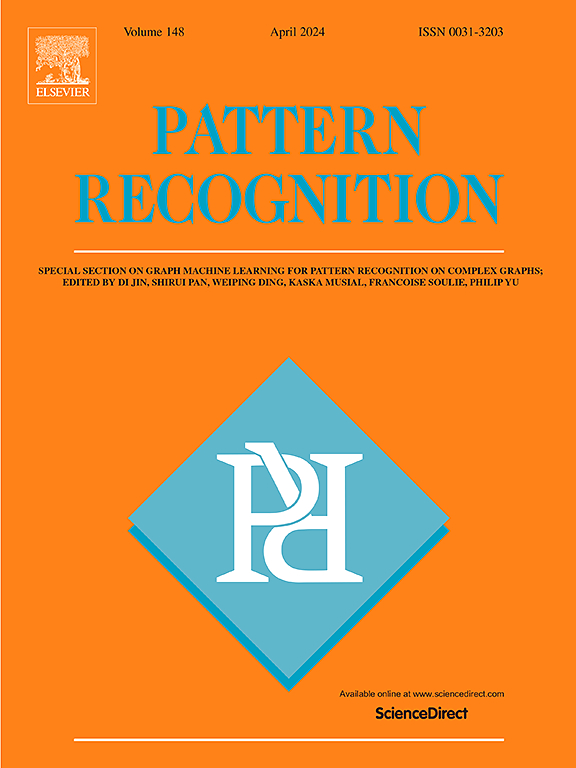用于高光谱解混的鲁棒斜投影和加权NMF
IF 7.5
1区 计算机科学
Q1 COMPUTER SCIENCE, ARTIFICIAL INTELLIGENCE
引用次数: 0
摘要
高光谱解混(HU)是遥感高光谱图像解译的一种关键方法,其目的是将遥感图像分解为场景中每个像素点的纯光谱分量(端元)及其丰度分数。然而,这种方法的有效性受到噪声和异常存在的阻碍。这种破坏主要是由大气效应和端元变异性等现实世界因素引起的。为了解决这一挑战,引入了一种称为图正则化斜投影加权NMF (GOP-WNMF)的新方法,该方法基于更精确的信号和噪声子空间分离,旨在提高分析的准确性和鲁棒性。GOP-WNMF通过构造一个倾斜投影器来实现这一点,该投影器将每个像素投影到信号子空间上,即由端元签名形成的空间,并平行于噪声子空间。这种方法有效地抑制了噪声,同时保留了关键的光谱信息。此外,我们的新斜NMF框架包括一种独特的基于残差的加权方法,可以同时检测和去除像素和光谱带中的异常。此外,通过建立连接端元和像素的二部图,提出了另一种加权矩阵,以提高生成的丰度图的平滑性和稀疏性。通过利用拉普拉斯特征映射技术来保持数据的流形结构,降低了像素异常值的负面影响,从而提高了丰度图估计的精度。通过对合成和真实hsi的综合测试来评估GOP-WNMF的有效性,并证明其优于多种最先进的方法。源代码也可从https://github.com/yasinhashemi/GOP-WNMF获得。本文章由计算机程序翻译,如有差异,请以英文原文为准。
Robust oblique projection and weighted NMF for hyperspectral unmixing
Hyperspectral unmixing (HU) is a crucial method for interpreting remotely sensed hyperspectral images (HSIs), with the aim of splitting the image into pure spectral components (endmembers) and their abundance fractions in every pixel of the scene. However, the effectiveness of this procedure is hindered by the presence of noise and anomalies. These kind of disruptions mainly arise from real-world factors such as atmospheric effects and endmember variability. To address this challenge, a novel approach called Graph-Regularized Oblique Projection Weighted NMF (GOP-WNMF) is introduced, which is grounded in a more precise separation of signal and noise subspaces, aiming to enhance the accuracy and robustness of the analysis. GOP-WNMF achieves this by constructing an oblique projector that projects each pixel onto the signal subspace, i.e., the space formed by signatures of endmembers, and parallel to the noise subspace. This approach effectively suppresses noise while preserving crucial spectral information. Furthermore, our new oblique NMF framework includes a unique residual-based weighting approach to detect and remove anomalies in pixels and spectral bands simultaneously. In addition to this, another weighting matrix is proposed by establishing a bipartite graph connecting endmembers and pixels to promote smoothness and sparsity in the resulting abundance maps. GOP-WNMF also enhances abundance map estimation accuracy by mitigating the negative effects of pixel outliers through the utilization of Laplacian eigenmaps technique to maintain the manifold structure of data. The effectiveness of GOP-WNMF is evaluated through comprehensive testing on synthetic and real HSIs, and its superiority is demonstrated over multiple state-of-the-art approaches. The source code is also available at https://github.com/yasinhashemi/GOP-WNMF.
求助全文
通过发布文献求助,成功后即可免费获取论文全文。
去求助
来源期刊

Pattern Recognition
工程技术-工程:电子与电气
CiteScore
14.40
自引率
16.20%
发文量
683
审稿时长
5.6 months
期刊介绍:
The field of Pattern Recognition is both mature and rapidly evolving, playing a crucial role in various related fields such as computer vision, image processing, text analysis, and neural networks. It closely intersects with machine learning and is being applied in emerging areas like biometrics, bioinformatics, multimedia data analysis, and data science. The journal Pattern Recognition, established half a century ago during the early days of computer science, has since grown significantly in scope and influence.
 求助内容:
求助内容: 应助结果提醒方式:
应助结果提醒方式:


